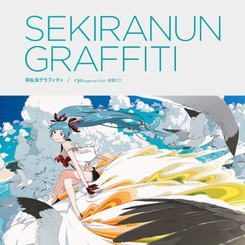Review
by Carlo Santos,Sekiranun Graffiti
Ryo (supercell) feat. Hatsune Miku
| Review: | ||||||||
"Sekiranun Graffiti" is the second supercell / Hatsune Miku release to hit American shores, a sign that the debut single from last May was more than just a promotional gimmick to get fans to come to the Miku show at Anime Expo 2011. However, listeners expecting more of the metallic vocals that came out of "World Is Mine" or "Black Rock Shooter" may be surprised to hear a warmer, closer-to-human Miku on "Sekiranun Graffiti"—the difference between a couple of 2008 songs and a release so recent that it came out in Japan on the same day. Like a guitarist going through different strings and picks, supercell's music mastermind Ryo has most likely spent the last few years refining the Miku sound until he got what he wanted. The result on the title track is by no means perfect—the vocals still hit certain notes with a metallic clunk, and post-production effects sometimes hide rough edges—but the distracting roboticness has been minimized to a point where one can concentrate on the overall arrangement. And the arrangement is a solid one: this is textbook supercell, with rock drums at weekend-roadtrip tempo, chunky electric guitars, and strings at full blast by mid-song. (For a genre associated with all things electronic, how funny that its most famous producer still thinks acoustically, modeling the arrangement after a standard rock band.) The verses are a bit monotone—Ryo's long melodic lines tend to drift on the same couple of chords—but the chorus has enough uplift, and a catchy enough hook, to be a blast of pure joy. The song's thoughtful lyrics, written by fellow Vocaloid producer Dixie Flatline, reflect upon a friendship that remains steadfast as the surrounding world changes. Yes, most of it is vague, sentimental filler, but the occasional bursts of water imagery—"sekiranun" means thundercloud, and there are references to rainstorms and the ocean—provide something concrete for Japanese-speaking listeners to hang on to. Songwriter and lyricist switch places for the B-side "Fallin' Fallin' Fallin'," and Dixie Flatline wastes no time in putting his trademark style out there. Glittering synth arpeggios give way to a head-bobbing house beat that should be familiar to anyone who's heard the ridiculously infectious "Just Be Friends," arguably Dixie Flatline's most well-known work. Unlike Ryo's melody- and harmony-driven songwriting, this track is built more around a steady groove, the kind you could take to a club (shame that it only lasts about three and a half minutes). As a side effect, however, the other aspects of song craftsmanship go ignored: the repeating synths and percussion stop being interesting halfway, and some string fills in the chorus do little to spice up an arrangement that sounds pretty homogeneous throughout. Even Miku's voice sounds less refined than on the title track, as if the producer purposely wanted to leave that harsh electronic edge in there. Hey, when the beat is just that good, why mess with anything else? However, the lyrics stand in sharp contrast to this danceable, uptempo track, as the words tell a tale (perhaps sarcastically) of desperate, unrequited love. If the lyrics to "Sekiranun Graffiti" are about the hope of true friendship, then "Fallin' Fallin' Fallin" is about the hopelessness of an impossible crush. The CD's crisp, brightly colored cover art by Atsuya Uki seems to agree: we see a smiling Miku riding across the clouds for the title track, while on the reverse, a more subdued version of her looks on wistfully as autumn leaves swirl about. And what does this mean in the context of the music? That the two songs are significantly different in style, but are both fun to listen to anyway. A remix of "Sekiranun Graffiti" by another Vocaloid producer, baker, rounds out the main body of material on the disc. Despite an attempt to make the song sound different by switching out rock instruments for synthesizers and adding a more "grimy" feel, the remix does little else to improve or transform the track. It might make the song more palatable for DJ material at a dance, but from a musical perspective, this is just some guy tinkering pointlessly with the original. Instrumental versions of the two songs are also included for the karaoke-addicted. For American fans who thought that the Hatsune Miku repertoire began and ended with what they saw at Anime Expo, "Sekiranun Graffiti" brings them up-to-date with the latest and greatest, as seen through the musical vision of producer Ryo. While one CD single cannot hope to represent the breadth of the Vocaloid meta-genre these days, it does bring a couple of other producers and their respective styles into the fold, and shows the versatility of the virtual idol's voice with contrasting A- and B-sides. But the most important thing is that these tracks make for pleasant listening, built upon solid songwriting concepts and distinctive arrangements. Is there still room for improvement in the genre? Absolutely. But seeing how things improve, and being part of that journey, is what makes it fun. |
||||||||
| Grade: | |||
|
Overall : B
+ Two contrasting songs demonstrate the variety of the Miku sound, while being fun to listen to. |
|||
| discuss this in the forum (5 posts) | | |||
